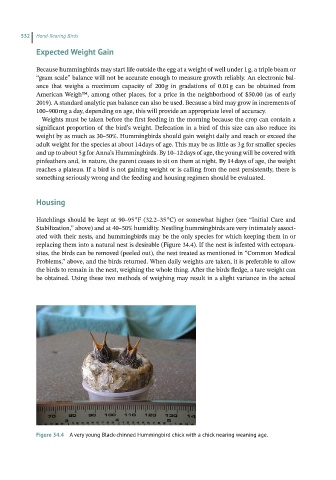Page 534 - Hand rearing birds second
P. 534
532 Hand-Rearing Birds
Expected Weight Gain
Because hummingbirds may start life outside the egg at a weight of well under 1 g, a triple beam or
“gram scale” balance will not be accurate enough to measure growth reliably. An electronic bal-
ance that weighs a maximum capacity of 200 g in gradations of 0.01 g can be obtained from
American Weigh™, among other places, for a price in the neighborhood of $50.00 (as of early
2019). A standard analytic pan balance can also be used. Because a bird may grow in increments of
100–900 mg a day, depending on age, this will provide an appropriate level of accuracy.
Weights must be taken before the first feeding in the morning because the crop can contain a
significant proportion of the bird’s weight. Defecation in a bird of this size can also reduce its
weight by as much as 30–50%. Hummingbirds should gain weight daily and reach or exceed the
adult weight for the species at about 14 days of age. This may be as little as 3 g for smaller species
and up to about 5 g for Anna’s Hummingbirds. By 10–12 days of age, the young will be covered with
pinfeathers and, in nature, the parent ceases to sit on them at night. By 14 days of age, the weight
reaches a plateau. If a bird is not gaining weight or is calling from the nest persistently, there is
something seriously wrong and the feeding and housing regimen should be evaluated.
Housing
Hatchlings should be kept at 90–95 °F (32.2–35 °C) or somewhat higher (see “Initial Care and
Stabilization,” above) and at 40–50% humidity. Nestling hummingbirds are very intimately associ-
ated with their nests, and hummingbirds may be the only species for which keeping them in or
replacing them into a natural nest is desirable (Figure 34.4). If the nest is infested with ectopara-
sites, the birds can be removed (peeled out), the nest treated as mentioned in “Common Medical
Problems,” above, and the birds returned. When daily weights are taken, it is preferable to allow
the birds to remain in the nest, weighing the whole thing. After the birds fledge, a tare weight can
be obtained. Using these two methods of weighing may result in a slight variance in the actual
Figure 34.4 A very young Black-chinned Hummingbird chick with a chick nearing weaning age.

